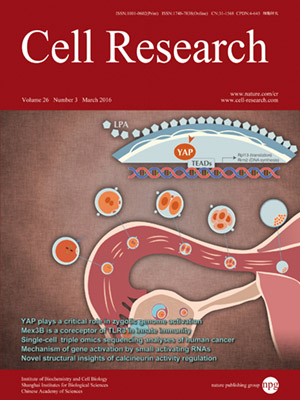
Volume 26, No 3, Mar 2016
ISSN: 1001-0602
EISSN: 1748-7838 2018
impact factor 17.848*
(Clarivate Analytics, 2019)
Volume 26 Issue 3, March 2016: 320-335 | Open Access
ORIGINAL ARTICLES
saRNA-guided Ago2 targets the RITA complex to promoters to stimulate transcription
Victoria Portnoy1,*, Szu Hua Sharon Lin1,*, Kathy H Li3, Alma Burlingame3, Zheng-Hui Hu1, Hao Li4 and Long-Cheng Li1,2
1Department of Urology and Helen Diller Family Comprehensive Cancer Center, University of California San Francisco, San Francisco, CA 94158, USA
2Laboratory of Molecular Medicine, Peking Union Medical College Hospital, Chinese Academy of Medical Sciences, Beijing 100730, China
3Department of Pharmaceutical Chemistry, University of California San Francisco, San Francisco, CA 94158, USA
4Department of Biochemistry and Biophysics, University of California San Francisco, San Francisco, CA 94158, USA
Correspondence: Long-Cheng Li, Tel: +86-10-69156281(lilongcheng@pumch.ac.cn)
Small activating RNAs (saRNAs) targeting specific promoter regions are able to stimulate gene expression at the transcriptional level, a phenomenon known as RNA activation (RNAa). It is known that RNAa depends on Ago2 and is associated with epigenetic changes at the target promoters. However, the precise molecular mechanism of RNAa remains elusive. Using human CDKN1A (p21) as a model gene, we characterized the molecular nature of RNAa. We show that saRNAs guide Ago2 to and associate with target promoters. saRNA-loaded Ago2 facilitates the assembly of an RNA-induced transcriptional activation (RITA) complex, which, in addition to saRNA-Ago2 complex, includes RHA and CTR9, the latter being a component of the PAF1 complex. RITA interacts with RNA polymerase II to stimulate transcription initiation and productive elongation, accompanied by monoubiquitination of histone 2B. Our results establish the existence of a cellular RNA-guided genome-targeting and transcriptional activation mechanism and provide important new mechanistic insights into the RNAa process.
10.1038/cr.2016.22
FULL TEXT | PDF
Browse 2481


